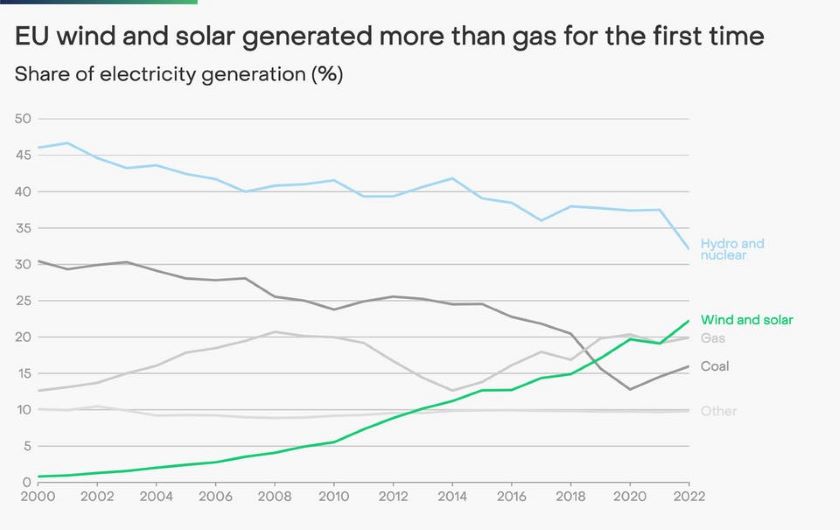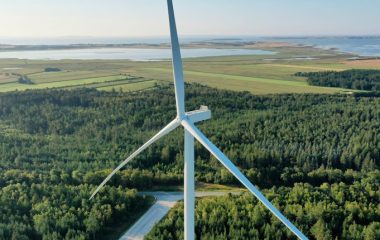
photo: iStock
The share of wind and solar electricity production reached 22% in the European Union last year, surpassing fossil gas for the first time, Ember said in its latest report. Despite the gas crisis and record low levels of nuclear and hydropower production, the EU has prevented the threat of a return to coal power, the independent energy think tank said.
The analysis of electricity generation for 2022 in EU countries – European Electricity Review showed that the share of electricity production from solar power plants and wind farms rose to a record 22%. For the first time, the two renewable energy technologies outperformed gas-fired power plants, which generated 20%.
The past year was also marked by a decline in electricity production in hydropower and nuclear plants. It was attributed to an extremely dry year and the overhaul of French nuclear capacities. Electricity from coal accounted for 16% of electricity production in the EU.
Optimistic notes in context of crisis
Ember said the European energy transition is emerging from the energy crisis “stronger than ever.” According to its forecasts, the share of fossil fuels, especially gas, will decrease in 2023.
In the context of the war in Ukraine, Ember believes Europe’s political response has accelerated the energy transition. The authors note the focus is currently on rapidly cutting gas demand and phasing out coal at the same time.
Record increase in solar power in 2022
Electricity production in solar power plants increased by a record 39 TWh or 24%. It is the result of an unprecedented annual increase in capacity – by 41 GW, or 47% more than in 2021.
In 2022, twenty EU countries increased the share of solar power plants to record levels
In 2022, twenty EU countries increased the share of solar power plants in their energy mix to a record level, according to Ember. The Netherlands tops the list with 14%, as the solar sector has surpassed coal production for the first time in the country.
At one point in October, Greece received electricity exclusively from renewable energy sources for five straight hours. The country expects to reach its 2030 target for 8 GW in overall solar power capacity by the end of this year.
Drought knocks down production of hydropower and in French nuclear power units
Last year’s drought resulted in the lowest level of hydroelectric generation in a century and disrupted the operation of nuclear power plants in France, right after Germany shut down three nuclear units.
Last year’s drought resulted in the lowest level of hydropower production in the EU since the beginning of the century
It created a large electricity generation gap, 185 TWh or 7% of total electricity demand in the EU, according to the analysis.
Gap was compensated by wind and solar
Five sixths of the resulting gap was compensated by the increase in wind and solar generation and the decline in demand. The rest was covered by an increase in the use of fossil fuels in electricity generation.

As the authors note, given that coal was cheaper than gas, its role grew and the consumption of the solid fuel increased by 7% from 2021. An additional 28 TWh was provided. Greenhouse gas emissions from the EU energy sector advanced 3.9% or by 26 megatons of carbon dioxide equivalent.
The production of electricity from gas remained almost unchanged, and there was no further increase in the share of gas.
It could have been much worse
It could have been much worse, but the expansion in the wind and solar sectors, together with the decline in electricity demand, prevented a much larger return to coal, the authors point out.
The expansion in the wind and solar sectors and the decline in electricity demand prevented a much larger return to coal
The share of electricity produced in coal-fired power plants increased by 1.5 percentage points. It reached 16%, remaining below the 2018 level. In the fourth quarter, it was even reduced, mainly due to the decline in electricity demand on an annual basis.
In the EU, 26 coal-fired power plants were put back on standby, but their average utilization in the last quarter was only 18%.
Reduced demand for electricity
Electricity demand in the EU fell by 7.9% in the last trimester from the same period of the previous year. This trend was observed in all EU countries, according to the authors. The last quarter of 2022 was warmer than in 2021.
Ember pointed out that the weather alone does not explain such large declines, but that they can probably be attributed to the solidarity that citizens showed in the reduction of energy demand during the crisis, alongside improvements in energy efficiency.
This year will be better
The institute estimated that in 2023, the situation will be quite the opposite. It is optimistic that hydropower plants and French nuclear units would recover, wind and solar deployment would accelerate, and that electricity demand would continue to weaken.
On the other hand, Germany has scheduled the closure of its three remaining nuclear power plants. Ember estimates that electricity production from fossil fuels could fall by 20% in 2023 or two times above the 2020 record.
Gas-fired power plants will suffer the biggest drop this year as the fuel will remain more expensive than coal at least by 2025, according to Ember’s analysis.









Be the first one to comment on this article.